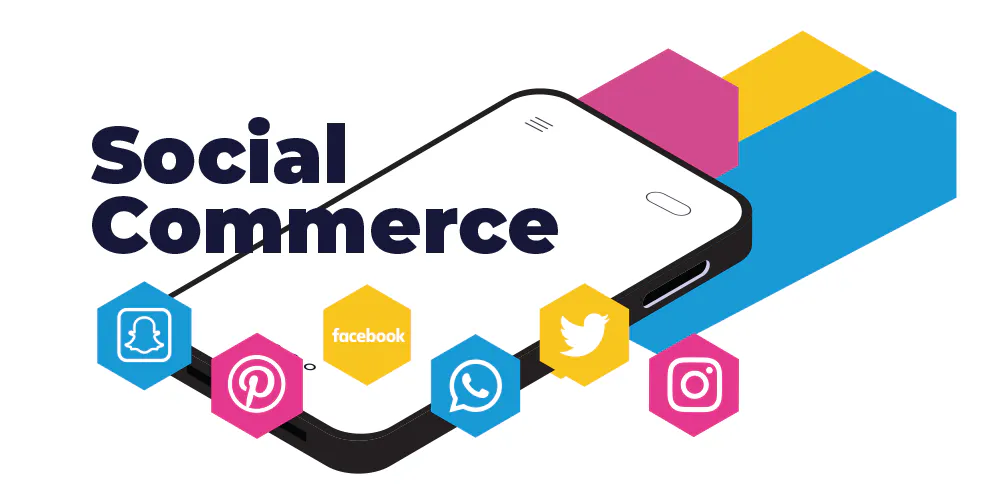Explore how social commerce is evolving in 2025, blending content creation with seamless shopping experiences. Learn how brands and creators can leverage Instagram, TikTok, YouTube, and emerging platforms to drive sales and build loyalty.
Introduction: The Convergence of Social Media and E-Commerce
Social commerce has evolved from a buzzword into a $1.2 trillion industry (Source: Statista, 2024), reshaping how brands sell and how consumers shop. In 2025, the line between content and conversion is blurrier than ever. Platforms like Instagram, TikTok, and YouTube now offer in-app checkout, live shopping, and AI-driven recommendations, allowing users to discover, engage, and purchase without leaving their feeds.
This guide explores how brands and creators can harness social commerce to turn casual scrollers into customers. From short-form video strategies to Web3-powered marketplaces, we’ll break down what’s working—and what’s next—for businesses aiming to thrive in this hybrid ecosystem.
Instagram: Visual Storytelling and Shop Integration
Instagram remains a powerhouse for social commerce, blending Reels, Stories, and direct-to-consumer tools.
Key Features:
- Instagram Shop: Tag products directly in posts and Reels for instant purchases.
- Reels Ads with Checkout: TikTok-style videos with embedded buy buttons.
- Live Shopping: Host interactive product demos with real-time purchases.
Content Strategies:
- Behind-the-Scenes Reels: Show how your product is made or used.
- User-Generated Content (UGC): Repost customer photos with tagged products.
- Influencer Takeovers: Let micro-influencers host your Instagram Live for authenticity.
Case Study: Fashion brand COS launched a TikTok-style Reel showcasing a limited-edition collection. The video included a “Shop Now” button and earned 2M views, driving 15K sales in 48 hours.
TikTok: Trend-Driven Purchases and Spark Ads
TikTok has become a top platform for impulse buying, with TikTok Shop and Spark Ads leading the charge.
Why It Works:
- Algorithmic Reach: TikTok’s For You Page surfaces trending products to new audiences.
- Trend-Jacking: Jump on viral sounds or challenges to promote products.
- Live Commerce: Host shopping events with influencers or founders.
Content Strategies:
- Educational Hacks: “This 5-Minute Trick Works Best with Our Product.”
- Product Launch Challenges: Encourage users to create content around your release.
- Creator Collabs: Partner with TikTok influencers for unboxing videos or tutorials.
Example: Beauty brand Fenty Beauty used TikTok Spark Ads to promote a new foundation shade range, earning 10M+ views and a 20% sales lift.
YouTube: Long-Form Influence and Shoppable Videos
YouTube’s blend of long-form content and Google search visibility makes it ideal for high-intent buyers.
Key Features:
- Shoppable Video Overlays: Add product links to tutorials or reviews.
- Live Stream Sales: Showcase products in real time with clickable links.
- Search-Driven Discovery: Optimize video titles and descriptions for keywords like “best skincare routine.”
Content Strategies:
- Tutorials and Demos: “How to Use [Your Product] for Maximum Results.”
- Customer Testimonials: Feature real users in video testimonials.
- Unboxing Videos: Encourage followers to film their experiences with your brand.
Case Study: Tech brand Dyson created a YouTube series titled “How to Clean Your Hair Tools at Home,” embedding shoppable links to their cleaning kits. The campaign drove 50K+ conversions in six weeks.
Pinterest: Search-Driven Inspiration and Affiliate Marketing
Pinterest thrives on intent-driven discovery, making it a goldmine for social commerce.
Why It Works:
- SEO Powerhouse: Pinterest pins rank in Google, driving evergreen traffic.
- Visual Search: Users pin products they want to buy later.
- Affiliate Integration: Earn commissions by linking to curated products.
Content Strategies:
- DIY and How-To Guides: “5 Easy Recipes Using Our Seasoning.”
- Style Inspiration: Create boards for fashion, home decor, or travel.
- Product-Focused Infographics: Highlight benefits and direct links to buy.
Pro Tip: Use Pinterest’s “Rich Pins” feature to automatically update pricing and availability.
Lemon8: The Lifestyle App That Blends Inspiration with Purchase
Lemon8, backed by ByteDance, is TikTok’s answer to Pinterest, focusing on lifestyle content with embedded shopping links.
Why It’s Gaining Momentum:
- Evergreen Content: Posts remain discoverable for months.
- Affiliate Partnerships: Earn revenue by recommending products.
- Seamless Transactions: Integrated payment systems for direct purchases.
Content Strategies:
- Travel and Food Guides: “Where to Stay in Bali (And What to Buy There).”
- Product Reviews: Honest takes on tools, gadgets, or skincare.
- Step-by-Step Tutorials: “How to Style This Outfit for Every Occasion.”
Example: A wellness brand posted a Lemon8 guide titled “Morning Routine Essentials,” linking to its products. The post earned 500K saves and drove 20K+ sales in a month.
Threads: The Microblogging Platform with Shopping Potential
Threads, Meta’s Twitter/X alternative, isn’t just for text—it’s evolving into a space for product storytelling and community-driven sales.
Why It’s Worth Exploring:
- Cross-Platform Visibility: Posts sync with Instagram and Facebook.
- Niche Conversations: Engage in discussions around your industry.
- Link-Heavy Culture: Threads allows multiple links per post, ideal for affiliate marketing.
Content Strategies:
- Threaded Thought Leadership: Share insights and link to your website or products.
- Community Polls: “Which product should we launch next?”
- Behind-the-Scenes Stories: Humanize your brand with process updates.
Pro Tip: Use hashtags like #ShopLocal or #DigitalNomadEssentials to reach niche audiences.
Emerging Trends in Social Commerce
As platforms evolve, so do the ways brands can monetize content.
1. AI-Powered Personalization
- Dynamic Product Recommendations: Tools like Heyday help brands tailor product suggestions based on user behavior.
- Chatbots for Customer Service: Use AI to answer questions and suggest products.
2. Augmented Reality (AR) Try-Ons
- Virtual Fitting Rooms: TikTok and Instagram now offer AR tools for trying products before buying.
- Interactive Filters: Let users see how your product looks in real time.
3. Web3 and NFT-Based Marketplaces
- Token-Gated Sales: Offer exclusive drops to NFT holders.
- Decentralized Marketplaces: Platforms like Mirror.xyz let creators sell digital and physical goods via crypto.
4. Social Media as a Search Engine
- Optimize for Discovery: Use keywords in captions and bios (e.g., “best travel backpack” or “clean skincare”).
- Leverage Hashtags for Search: Mix trending and niche tags to boost visibility.
How Creators and Brands Can Monetize Social Commerce
Social commerce isn’t just for big brands—creators can monetize their influence through affiliate marketing, sponsored content, and direct sales.
1. Creator-Led Marketplaces
- Digital Products: Sell courses, templates, or presets via TikTok or Instagram Shops.
- Commission-Based Sales: Earn a cut by promoting other brands’ products.
- Limited Edition Drops: Launch exclusive merchandise with a built-in audience.
2. Influencer Partnerships
- TikTok Spark Ads: Collaborate with influencers to boost visibility.
- Instagram Reel Takeovers: Let creators showcase your product in their daily routine.
- YouTube Sponsorships: Feature products in long-form reviews or vlogs.
Case Study: A fitness coach partnered with a supplement brand for an Instagram Reel showcasing her routine. The post included a discount code, earning $10K in commissions.
The Role of User-Generated Content (UGC) in Driving Sales
UGC remains one of the most powerful tools in social commerce. A TurnTo Networks study found that posts featuring real customers drive 2x more engagement than branded content.
Ways to Encourage UGC:
- Hashtag Campaigns: Launch challenges like #MyLemon8Style or #OOTD.
- Repurpose Reviews: Share customer stories in Reels or TikTok videos.
- Feature Followers: Tag users who post about your product.
Example: Outdoor brand Patagonia reposted customer photos of their jackets in action, boosting trust and driving 10K+ orders from a single post.
Live Commerce: Real-Time Buying Experiences
Live shopping events are booming. In 2025, platforms like Instagram, TikTok, and YouTube offer live commerce tools that blend entertainment with instant purchase options.
How to Leverage Live Shopping:
- Host Q&A Sessions: Answer product questions in real time.
- Limited-Time Offers: Use countdowns and flash sales to create urgency.
- Collaborate with Influencers: Co-host live events with creators in your niche.
Case Study: Jewelry brand Pandora hosted a TikTok live with influencer @StyleWithJen, offering a 20% discount for first-time buyers. The stream earned 1M views and 50K sales.
Challenges in Social Commerce (And How to Overcome Them)
Despite its potential, social commerce comes with hurdles.
1. Trust and Transparency
- Fix: Disclose partnerships and sponsorships clearly. Use honest reviews and testimonials.
2. Platform Saturation
- Fix: Focus on niche audiences. A makeup brand might target “vegan beauty” communities on TikTok.
3. Algorithm Changes
- Fix: Stay agile by testing multiple formats and platforms. Use analytics to refine your approach.
4. Payment Friction
- Fix: Simplify checkout with one-click options and clear CTAs.
5. Competing with Big Brands
- Fix: Lean into community and personalization. A small skincare brand could offer custom routines via DMs.
The Future of Social Commerce in 2025 and Beyond
Social commerce isn’t a trend—it’s the future. Here’s what to expect:
- More Direct-to-Consumer Tools: Platforms will expand in-app shopping to reduce friction.
- AI-Driven Personalization: Expect tailored product suggestions based on browsing history.
- Voice and Visual Search: Pinterest and Google Lens will integrate more deeply with social apps.
- Web3 Integration: NFTs may unlock exclusive drops or loyalty rewards.
Expert Insight: According to Forbes, by 2026, 40% of e-commerce transactions will begin on social media, making early adoption critical.
Conclusion: Build Relationships, Not Just Sales Pitches
Social commerce success in 2025 hinges on blending storytelling with seamless shopping experiences. Start by:
- Identifying the platforms where your audience spends time.
- Creating content that educates, entertains, or inspires.
- Testing live shopping, UGC, and shoppable Reels.
- Tracking performance with UTM links and Google Analytics.
By aligning your strategy with platform-specific trends and user behavior, you’ll turn engagement into revenue—without sacrificing authenticity.
FAQs
Q1: What is social commerce?
A: Social commerce is the integration of shopping features into social media platforms.
Q2: Which platforms are best for social commerce in 2025?
A: Instagram, TikTok, YouTube, and emerging apps like Lemon8 and Threads.
Q3: How can creators monetize social commerce?
A: Through affiliate links, brand partnerships, and selling their own digital or physical products.
Q4: Should I focus on one platform or multiple?
A: Start with one or two platforms, then expand based on performance.
Q5: What’s the biggest mistake in social commerce?
A: Pushing sales too hard without building trust or offering value.





